You are using an out of date browser. It may not display this or other websites correctly.
You should upgrade or use an alternative browser.
You should upgrade or use an alternative browser.
Well, during the lockdown I bought Tata Power stock at 76. It's at 231 right now. So you won't see me complaining. In fact, every Tata stock has pretty much hit the spot.
Clean, green energy based ETF's are solid investment long term right now more broadly.
1.25 lakh crore = 17 billion USD
50,000 crore = 7 billion USD
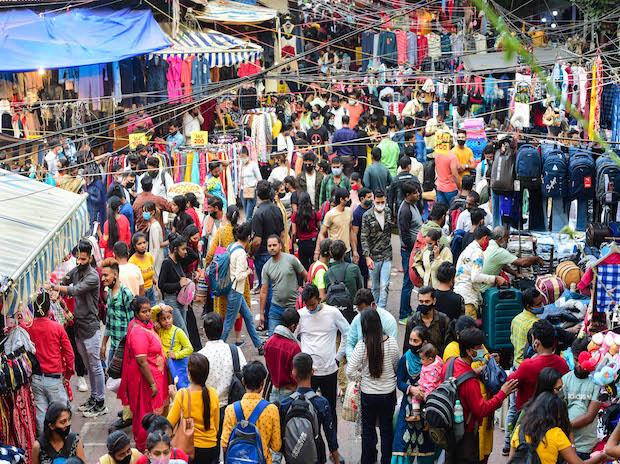
 www.business-standard.com
www.business-standard.com
Bhartia and Khandelwal said consumers preferred Indian goods this time, leading to a direct loss of over Rs 50,000 crore (7 billion USD) of business to Chinese exporters.
@Viva_vietnamm

50,000 crore = 7 billion USD

Diwali festive sale crosses Rs 1.25 trn, breaks all records in 10 yrs: CAIT
Local shops on Amazon clocked a 2x spike and sold over 10 products every minute
Bhartia and Khandelwal said consumers preferred Indian goods this time, leading to a direct loss of over Rs 50,000 crore (7 billion USD) of business to Chinese exporters.
@Viva_vietnamm
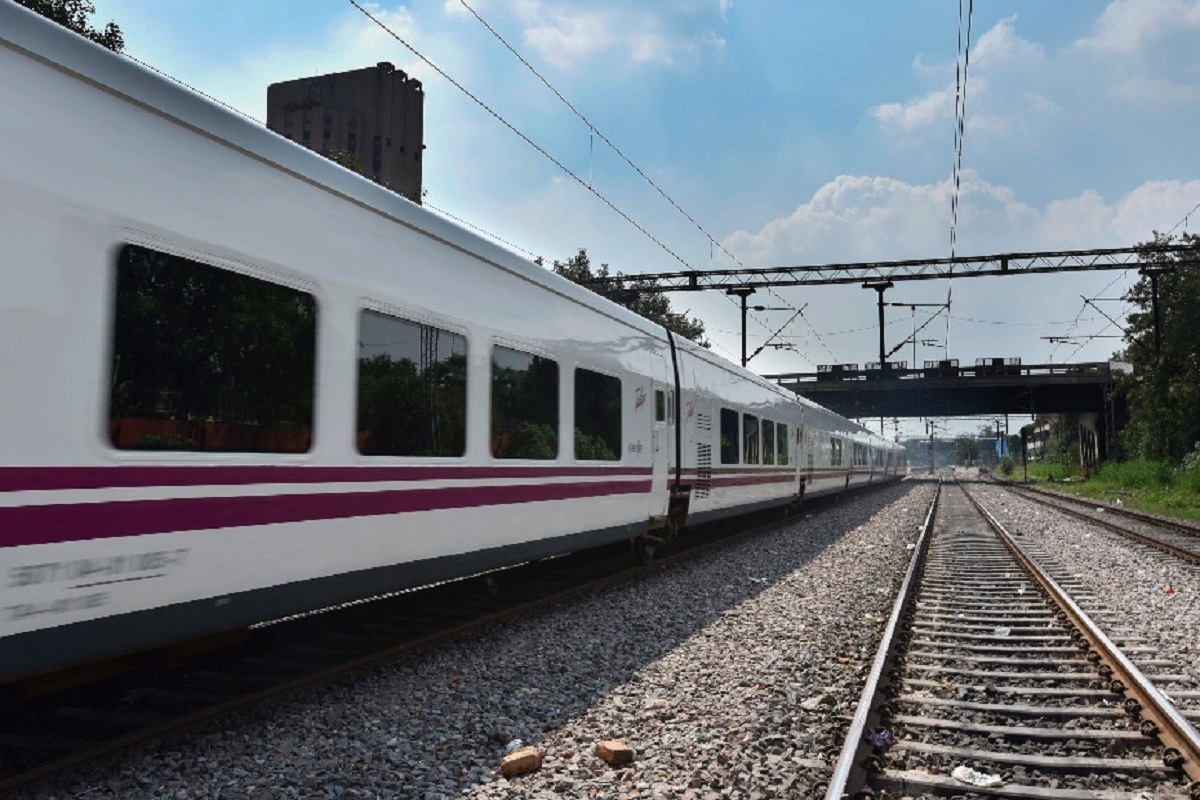
Mission Raftar: Rs 5,550 Crore High Power Supply System To Run Trains At 160 Kmph - India Infra Hub
Snapshot Mission Raftar aims to reduce travel time on busy routes by running passenger-carrying trains at maximum speed of 160 kmph. Setting the Mission Raftar in motion, Indian Railways has undertaken the upgradation of over head equipment (OHE) and strengthening of power supply system on...
 indiainfrahub.com
indiainfrahub.com

India manufacturing PMI hits 8-month high in October
While strong growth of both sales and production were noted in each of the three broad areas of the manufacturing sector, it was in intermediate goods that the sharpest rates of expansion were recorded
Thats a huge amount, India bro should try hareder to attract more factories that wanna quit CN due to trade war and higher tax1.25 lakh crore = 17 billion USD
50,000 crore = 7 billion USD

Diwali festive sale crosses Rs 1.25 trn, breaks all records in 10 yrs: CAIT
Local shops on Amazon clocked a 2x spike and sold over 10 products every minutewww.business-standard.com
Bhartia and Khandelwal said consumers preferred Indian goods this time, leading to a direct loss of over Rs 50,000 crore (7 billion USD) of business to Chinese exporters.
@Viva_vietnamm View attachment 35148
-----------------
From December 1, China will only receive preferential tariffs from 3 countries Norway, New Zealand and Australia.
According to information from the General Administration of Customs of China, from December 1, 32 countries will stop applying preferential tariffs to this country. One economist predicts that labor-intensive businesses will be affected when the decision officially takes effect.Specifically, according to a notice on October 28 by the General Administration of Customs of China, starting from December 1, Chinese goods exported to "EU member countries, the United Kingdom, Canada, Turkey, Ukraine and Liechtenstein" will no longer be granted GSP (Generalized System of Preferences) certificates.
As its name suggests, GSP is a system of preferential tariffs of developed countries for exports from developing countries and regions by reducing or exempting taxes.
China's General Administration of Customs "welcomes" the move to suspend GSP issuance as "recognition from other developed economies that China is no longer in the group of low- and middle-income countries, and products Chinese products are competitive enough in the market, no longer need 'them' protection."
"We are 'graduating' from the GSP (General System of Preferences) program and moving towards becoming a 'mature' economy," the announcement states.
Thus, the notice of the General Administration of Customs of China indirectly confirmed that 32 countries (including 27 EU countries, the United Kingdom, Canada, Turkey, Ukraine and Liechtenstein) have canceled trade treatment for with China.
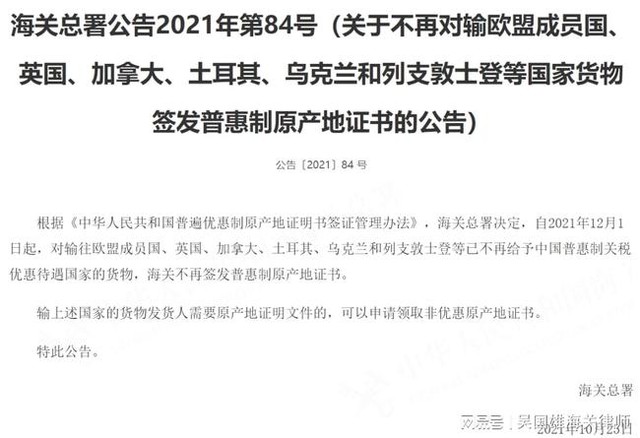
Notice of General Administration of Customs of China
According to Taiwan News, China started receiving GSP trade preferences since 1978, and a total of about 40 countries have or are granting China tax exemption certificates for certain exports. Previously, Switzerland, Japan, Russia, Kazakhstan and Belarus (members of the Eurasian Economic Union) stopped giving preferential tariff treatment to China.
Thus, from December 1, China will only receive preferential tariffs from 3 countries Norway, New Zealand and Australia.
Deputy Secretary General of the Chunghwa Economic and Financial Association (Taiwan), Tseng Chih-Chao, said that ending duty-free market access for China has little impact on exports overall, but Labor-intensive and low-margin businesses will bear the brunt – and this could lead to the relocation of manufacturing plants in China to other developing countries.
Previously, some Chinese news sites confused the GSP preferential tariff certificate with the WTO's most-favored nation (MFN) principle, causing some readers to worry that this move would bring China back to the previous era. when it joined the WTO 20 years ago.
32 countries including EU end tariff preferences for China
From December 1, China will only receive preferential tariffs from 3 countries Norway, New Zealand and Australia. According to information from the General Administration of Customs of China, from December 1, 32 countries will stop applying preferential tariffs to this country. One economist...
 defencehub.live
defencehub.live
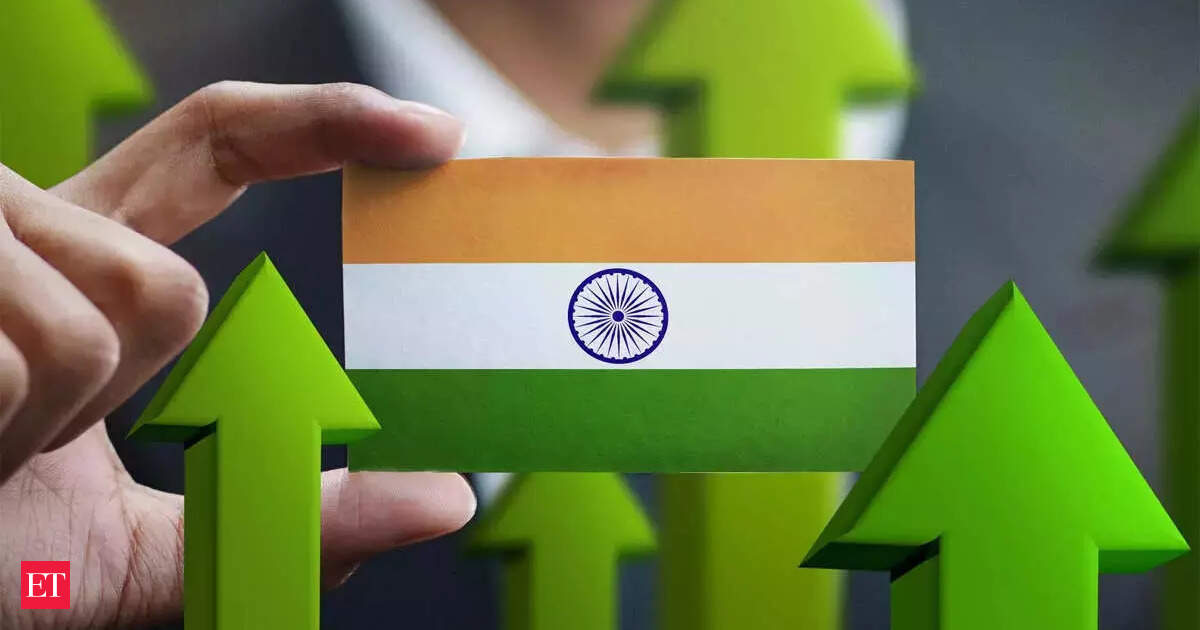
India's economic recovery gains momentum in recent months: PHDCCI Economy GPS Index
The PHDCCI Economy GPS Index, based on the monthly values of three high-frequency indicators viz., GST collection (Rs crore), passenger vehicle sales (units) and Sensex (daily average), helps to find the direction of the economy.
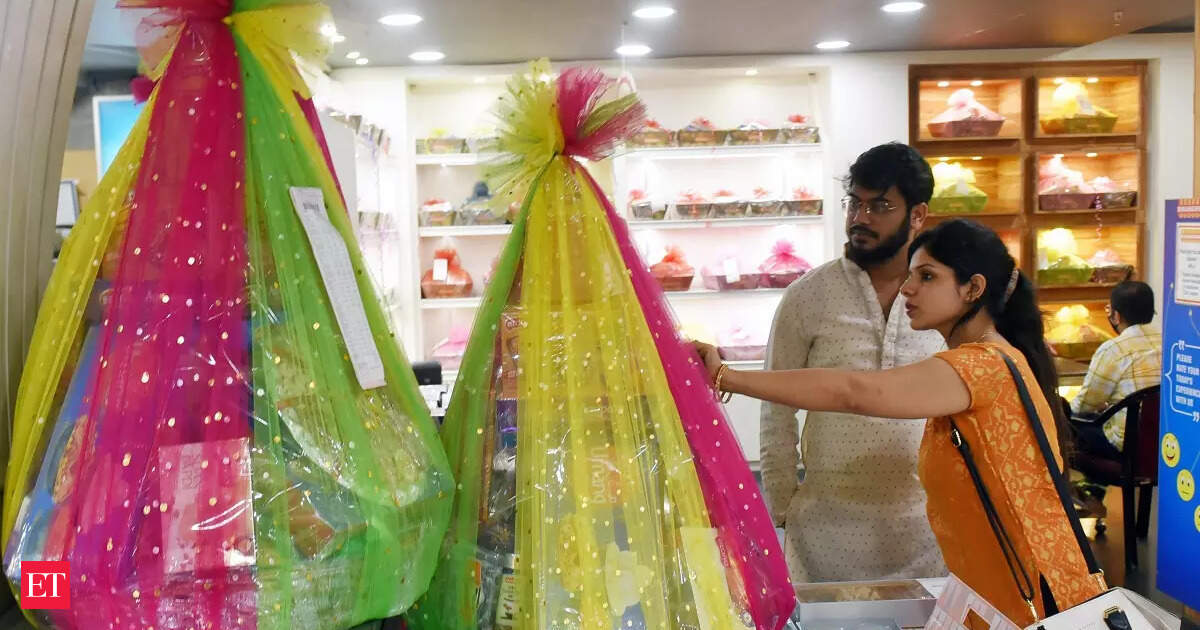
How strong is the economic recovery? Economists go the extra mile to find out
A string of high-frequency alternative indicators, along with government-issued data sets such as goods and services tax (GST) collection, foreign trade, e-way bills and Purchasing Managers Index (PMI), have shown the economy has gathered pace. But gauging the true extent of recovery is proving...
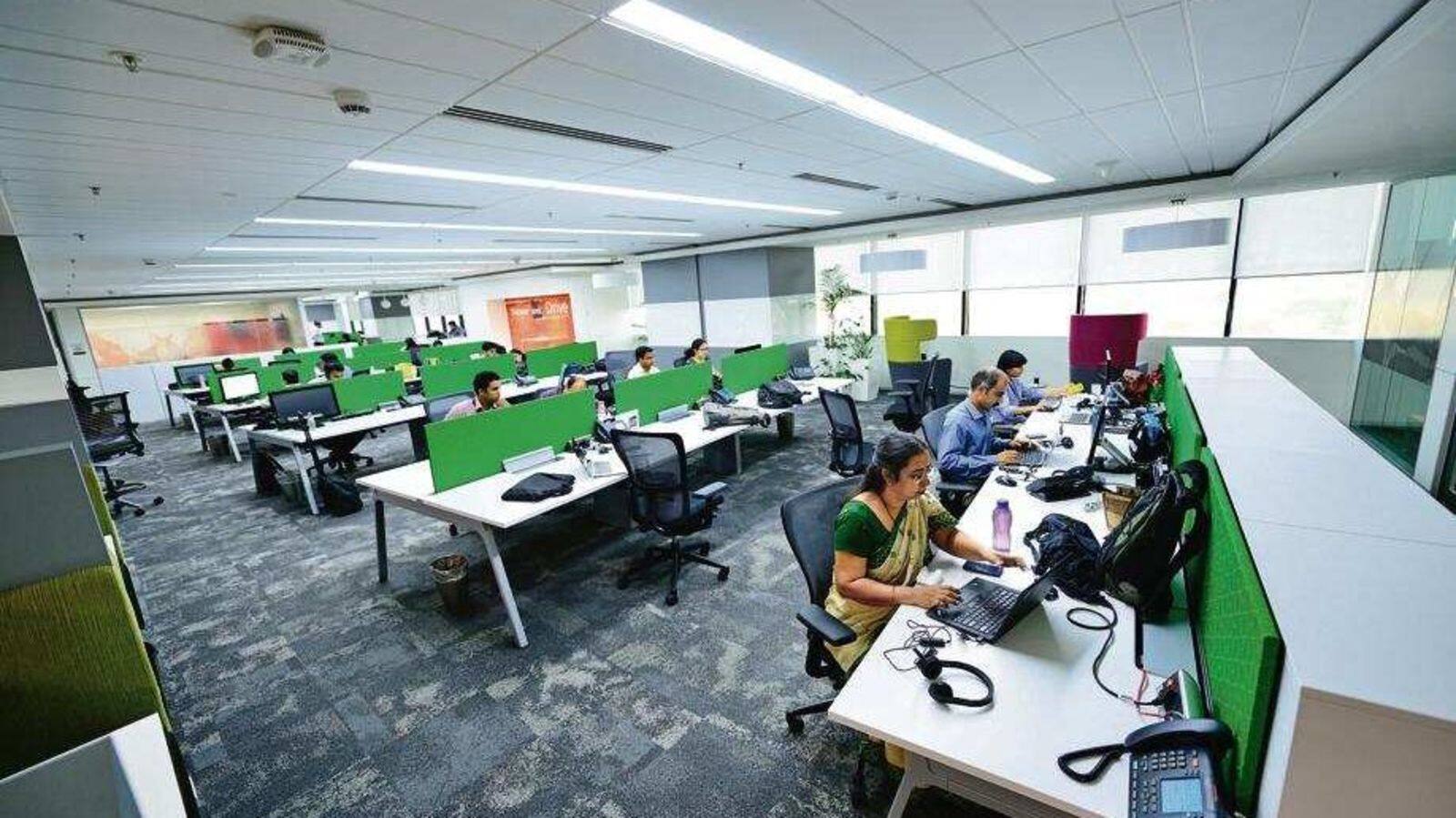
India services activity in October rises at fastest pace in 10 years: PMI survey
Services companies continued to hire additional workers in October: India PMI survey
October data highlighted a sixteenth successive monthly increase in input costs
-New orders rise at joint-fastest pace since July 2011
-Indian firms were able to secure a healthy intake of new work despite charging more for their services.
-Services companies continued to hire additional workers in October. Although moderate, the pace of job creation quickened from
September to the strongest since February 2020
@Indos , understand this....its REAL news like this that drives the anger and frsutration of a particular vicious loser in PDF (and his little pack of dullards that have driven away the actual smarter ones from that subsection about eastern neighbour of India)
You can see for yourself if in your own lifetime (forget about the "5 year plan target"),if they get anywhere close to "5 billion" objective....which in itself is a really low level.
It is simply a matter if that country appoints fellows like that (loser) in anywhere near any decision making....if they dont they have a chance.
The good news for that country is they soundly reject people like that mostly...its why those types have crawled and made their home in such forums like that.....only vile words and no actual brains, brawn or action.
But past that PDF-toxic-gang....they still have too much incompetence/corruption at highest level fudging their numbers still (IMF showed recently a FULL 15% of their forex reserve claim is essentially fake by world standard).
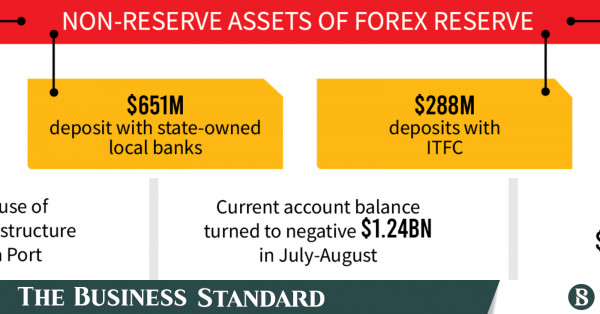
Forex reserves overstated by $7.2bn: IMF
The foreign exchange reserve of $46 billion as reported at the end of June this year was overstated by 15%

Can’t have your cake and eat it too
A 15% overstatement in counting official reserves is no trivial matter. The IMF findings in this regard are concerning. Forewarned is forearmed, says an old proverb. Reserve asset portfolios have special characteristics that distinguish them from other foreign currency assets. There are...
You can ask those guys (if you dare lol) what does that mean for nominal GDP and other forex macro-conversion process
Unfortunately they will just screech I think....like ignorants all do.
The dissonance btw shows up from space (simple light output of population observed by satellites)....as to who's GDP dollar conversion is actually more valid...
Honestly you are better off chatting here about these topics (and get concise replies that actually mean something).....too many stupid worthless ones have gathered over there with their loser agenda.

India Adds Over 1.5 Lakh Megawatt Installed Power Capacity In Last Seven Years - India Infra Hub
The ministry of power said that India added 1,55,377 megawatt (MW) to the installed power capacity in the country in the last seven years. According to the ministry, India had a massive power deficit of 16.6 per cent in 2007-08. Even in 2011-12, it was 10.6 per cent. “Through the multi pronged...
 indiainfrahub.com
indiainfrahub.com

India Adds Over 1.5 Lakh Megawatt Installed Power Capacity In Last Seven Years - India Infra Hub
The ministry of power said that India added 1,55,377 megawatt (MW) to the installed power capacity in the country in the last seven years. According to the ministry, India had a massive power deficit of 16.6 per cent in 2007-08. Even in 2011-12, it was 10.6 per cent. “Through the multi pronged...
 indiainfrahub.com
indiainfrahub.com
India Adds Over 1.5 Lakh Megawatt (150 GW) Installed Power Capacity In Last Seven Years
November 8, 2021 by India Infra Hub StaffThe ministry of power said that India added 1,55,377 megawatt (MW) to the installed power capacity in the country in the last seven years.
According to the ministry, India had a massive power deficit of 16.6 per cent in 2007-08. Even in 2011-12, it was 10.6 per cent.
“Through the multi pronged, comprehensive and aggressive interventions of the government, this deficit is nearly wiped out, consistently over the last 3 years: .4 per cent in 2020-21, .7 per cent in 2019-20 and .8 per cent in 2018-19,” the ministry said in a statement.
“The current year, up till October, it has been 1.2 per cent; the marginal spike being attributable to the annual post monsoon pressure on power output. This is also likely to normalize by the end of the year,” it added.
The ministry said that this transformation from an acute power deficit country, to a situation of demand being met, except for an extremely marginal shortfall of less than one per cent, has been made possible by schemes like Deen Dayal Upadhyaya Gram Jyoti Yojana (DDUGJY), Integrated Power Development Scheme (IPDS) and Pradhan Mantri Sahaj Bijli Har Ghar Yojana (Saubhagya) scheme brought in by the current government to address the deficit situation.
The Deen Dayal Upadhyaya Gram Jyoti Yojana (DDUGJY), was brought in on 25 July 2015 for infrastructure push in the rural sector – setting up transmission and sub-transmission systems. The Integrated Power Development Scheme ( IPDS), was brought in on 20 November 2014 to fill in power infrastructure gaps in urban areas.
The Pradhan Mantri Sahaj Bijli Har Ghar Yojana (Saubhagya) scheme launched on 25 September 2017, had the vision to take electricity to every household (willing) and has been able to give electricity connections to 2.8 crore households which were hitherto in darkness.
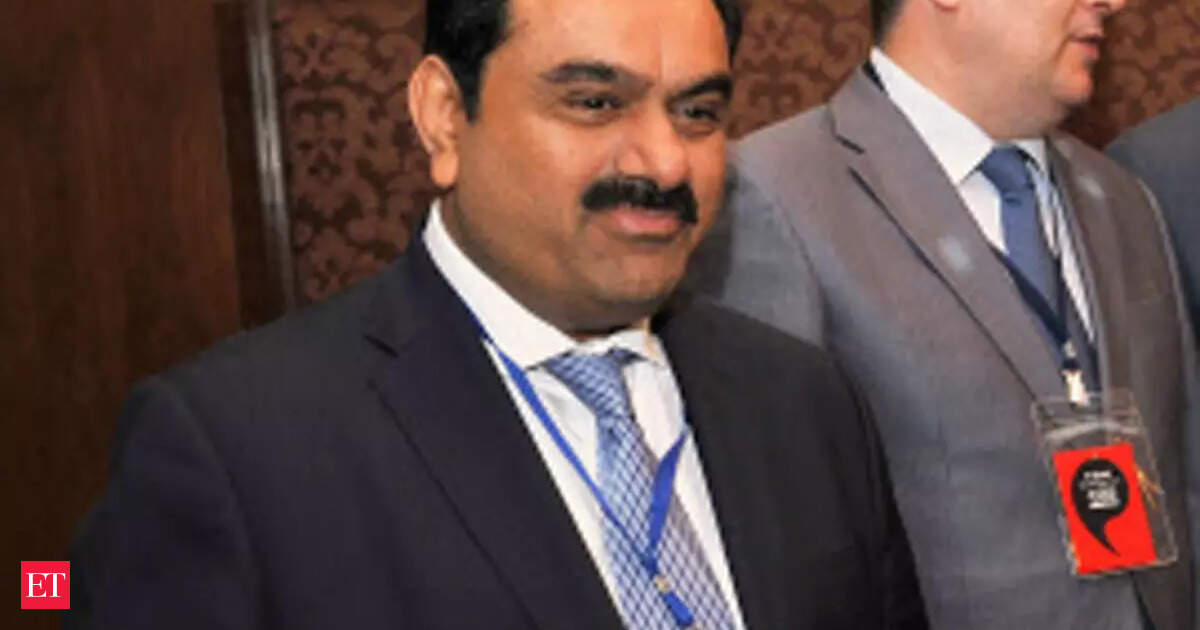
Adani to invest $70 bn in renewable energy, produce cheapest hydrogen
India's billionaires, including Mukesh Ambani and Gautam Adani, are pledging huge investments, while PM Modi is setting up a renewables park the size of Singapore in Gujarat. Speaking at the Bloomberg India Economic Forum, Adani Group's founder-chairman said the group is working to make...
https://economictimes.indiatimes.com/marketstats/pid-40,exchange-nse,sortby-value,sortorder-desc.cms
India's billionaires, including Mukesh Ambani and Gautam Adani, are pledging huge investments, while PM Modi is setting up a renewables park the size of Singapore in Gujarat.
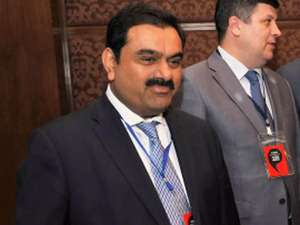
Billionaire Gautam Adani on Thursday said his logistics-to-energy conglomerate will invest USD 70 billion over the next decade to become the world's largest renewable energy company and produce the cheapest hydrogen on the Earth. Adani Green Energy Ltd (AGEL), the world's largest solar power developer, is targeting 45 gigawatts of renewable energy capacity by 2030 and will invest USD 20 billion to develop a 2 GW per year solar manufacturing capacity by 2022-23.
Adani Transmission Ltd (ATL), India's largest private sector power transmission and retail distribution company, is looking to increase the share of renewable power procurement from the current 3 per cent to 30 per cent by FY 2023 and to 70 per cent by FY 2030.
Speaking at the Bloomberg India Economic Forum, Adani NSE 0.55 % Group's founder-chairman said the group is working to make renewable a viable, affordable alternative to fossil fuels.
"By 2030, we expect to be the world's largest renewable energy company without any caveat - and we have committed USD 70 billion over the next decade to make this happen. There is no other company that has yet made so large a bet on developing its sustainability infrastructure," he said.
Adani Group already is the world's largest solar power developer.
"We, therefore, believe the combination of our renewable capacity and the size of our investment makes us the leader among all global companies in the effort to produce cheap green electricity and green hydrogen," he said without giving details of the plans to produce hydrogen.
"From an Adani perspective, we are very strongly positioned to produce the world's least expensive hydrogen, which is expected to be an energy source plus feedstock for various industries that we intend to play in," he said.
Stating that green hydrogen, produced from renewable energy, is a miracle fuel and a miracle feedstock, he said India's exponential growth in renewables, producing green hydrogen cheaply could transform the nation into a net exporter of green energy.
"Imagine that - an India no longer having to rely on imported fossil fuels, an India no longer exposed to the price fluctuations of international markets, an India that achieves fuel independence," he said.
At COP 26 in Glasgow, Prime Minister Narendra Modi announced 2070 as India's target year to reach net-zero carbon emissions.
India also announced a slew of other, more ambitious, climate targets for 2030: increasing the share of renewables in the country's energy mix to 50 per cent; expanding installed capacity of non-fossil energy from 450 to 500 GW; and reducing the carbon intensity of the economy by 45 per cent, as opposed to the previous goal of 33-35 pr cent.
"Ahead of COP 26, the Climate Change Conference in Glasgow, I pointed out that businesses that act on the urgent need to limit incremental global warming will secure the largest opportunities over the next several decades. Balancing growth while limiting emissions is an incredible global opportunity for businesses that are prepared to adapt," Adani said.
In this race to avert ecological disaster, the world could use Indian leadership. India's track record in living up to its sustainability commitments is better than that of any other major nation, he said.
At COP 21 in Paris, India promised that, by 2030, it would curtail the emissions intensity of its GDP by 33-35 per cent and increase its share of non-fossil power capacity to 40 per cent. "We have beaten both targets, the latter nine years ahead of schedule," he said.
Adani said the new targets will not be easy.
"Every political and business leader will be confronted with decisions requiring them to disrupt existing regulations as well as disrupt existing business models. Combine this with the disruptions in the digital space that has engulfed every field, and we have a near-perfect storm.
"This storm will cause the collapse of many massive multinational businesses, only for them to be replaced by new multi-trillion-dollar companies arising from the intersection of sustainability and digital technologies," he said.
In other words, the future of infrastructure to enable a greener world will require both sustainability and digital innovation to be at the core of both design and execution, Adani added.
Adani said over the past years, his group has focused on turning all the businesses, be it electricity, ports and logistics, airport and transport, and data-centers green.
Stating that in 2025 it is estimated an individual in the developed world will have one interaction with a data center every 20 seconds, he said as 5G connectivity expands enterprise networks and moves data processing to the edge, there is a need to reimagine data center designs.
"The Adani Group is well-positioned to benefit from this trend given our ability to build data centers, connect data centers, and provide 100 per cent green power to data centers - a provision that will be hard to replicate at an economic scale elsewhere in the world," he said.
To that end, Adani Group is also making major investments in digital infrastructure. Data centers, cloud computing and artificial intelligence vastly improve access to information, real-time data, and energy efficiency.
IND - JPN cooperation continues to grow.
Some forums with lot of larpers like to blab 1000s of posts about japan "proposed"/"MOU" investment into them
India prefers to just DO...

 finance.yahoo.com
finance.yahoo.com
SoftBank Group chief executive Rajeev Misra said the fund has invested $3 billion in Indian companies this year and can invest $5 billion to $10 billion next year, the latest aggressive play by a top investment firm in the South Asian nation, where young firms have raised over a record $20 billion this year.
“If we find the right companies, we could invest $5 billion to $10 billion in 2022,” said Misra at a virtual conference on Thursday, adding the caveat that SoftBank will explore such opportunities “at the right valuations.”
Misra said the firm has slowed the pace of investment in China, but will continue to stay in it as the Asian economy is a major center of AI in the world.
Scores of global investors deployed tens of billions of dollars in India in the past decade as they searched for early winners in the world’s second-most populous nation. The dealflow activities have surged significantly this year as Tiger Global, SoftBank, Falcon Edge Capital and Sequoia Capital India have aggressively chased deals and backed firms at record valuation jumps.
Tiger Global, in particular, has backed over two dozen startups, many still in early stages of their journeys, in India this year. The firm reportedly told shareholders earlier this year that India was one of the top priorities with its new fund.
India has also been a major focus for SoftBank in the past several years. Misra said there's been an "amazing turnaround" in India, where once it was difficult to justify investments.
The Japanese conglomerate has helped shape many young Indian startups. Some of its investments include payments firm Paytm and budget hotel chain Oyo, both of which have filed for initial public offerings.
It’s also a backer of Flipkart, which sold a majority stake to Walmart in 2018. SoftBank, which had exited the firm during the acquisition, has since deployed more capital in Flipkart. Ola, the ride-hailing giant in India that is also backed by SoftBank, is also planning to explore the public markets next year. "There’s a lot of pent-up demand for tech IPOs," Misra said.
SoftBank is looking to invest in more startups this year, he said. Misra identified fintech as one of the major thematic focuses that SoftBank is exploring in India. He said in the virtual conference, held by Bloomberg, that innovation in the financial inclusion space is a key to India’s goal of becoming a $5 trillion economy.
Some forums with lot of larpers like to blab 1000s of posts about japan "proposed"/"MOU" investment into them
India prefers to just DO...
SoftBank has deployed $3 billion in India this year, can invest up to $10 billion in 2022
“If we find the right companies, we could invest $5 billion to $10 billion in 2022,” said Misra at a virtual conference on Thursday, adding the caveat that SoftBank will explore such opportunities “at the right valuations.” Scores of global investors deployed tens of billions of dollars in...
SoftBank has deployed $3 billion in India this year, can invest up to $10 billion in 2022
SoftBank Group chief executive Rajeev Misra said the fund has invested $3 billion in Indian companies this year and can invest $5 billion to $10 billion next year, the latest aggressive play by a top investment firm in the South Asian nation, where young firms have raised over a record $20 billion this year.
“If we find the right companies, we could invest $5 billion to $10 billion in 2022,” said Misra at a virtual conference on Thursday, adding the caveat that SoftBank will explore such opportunities “at the right valuations.”
Misra said the firm has slowed the pace of investment in China, but will continue to stay in it as the Asian economy is a major center of AI in the world.
Scores of global investors deployed tens of billions of dollars in India in the past decade as they searched for early winners in the world’s second-most populous nation. The dealflow activities have surged significantly this year as Tiger Global, SoftBank, Falcon Edge Capital and Sequoia Capital India have aggressively chased deals and backed firms at record valuation jumps.
Tiger Global, in particular, has backed over two dozen startups, many still in early stages of their journeys, in India this year. The firm reportedly told shareholders earlier this year that India was one of the top priorities with its new fund.
India has also been a major focus for SoftBank in the past several years. Misra said there's been an "amazing turnaround" in India, where once it was difficult to justify investments.
The Japanese conglomerate has helped shape many young Indian startups. Some of its investments include payments firm Paytm and budget hotel chain Oyo, both of which have filed for initial public offerings.
It’s also a backer of Flipkart, which sold a majority stake to Walmart in 2018. SoftBank, which had exited the firm during the acquisition, has since deployed more capital in Flipkart. Ola, the ride-hailing giant in India that is also backed by SoftBank, is also planning to explore the public markets next year. "There’s a lot of pent-up demand for tech IPOs," Misra said.
SoftBank is looking to invest in more startups this year, he said. Misra identified fintech as one of the major thematic focuses that SoftBank is exploring in India. He said in the virtual conference, held by Bloomberg, that innovation in the financial inclusion space is a key to India’s goal of becoming a $5 trillion economy.
Today, domestic savings stand at $1 trillion and are expected to reach $3 trillion in the next decade...

 www.moneycontrol.com
www.moneycontrol.com

Daily Voice | India's domestic savings to reach $3 trillion next decade, says Manisha Girotra of Moelis
Domestic large-cap companies will continue to accelerate their footprint with inorganic acquisitions going ahead.
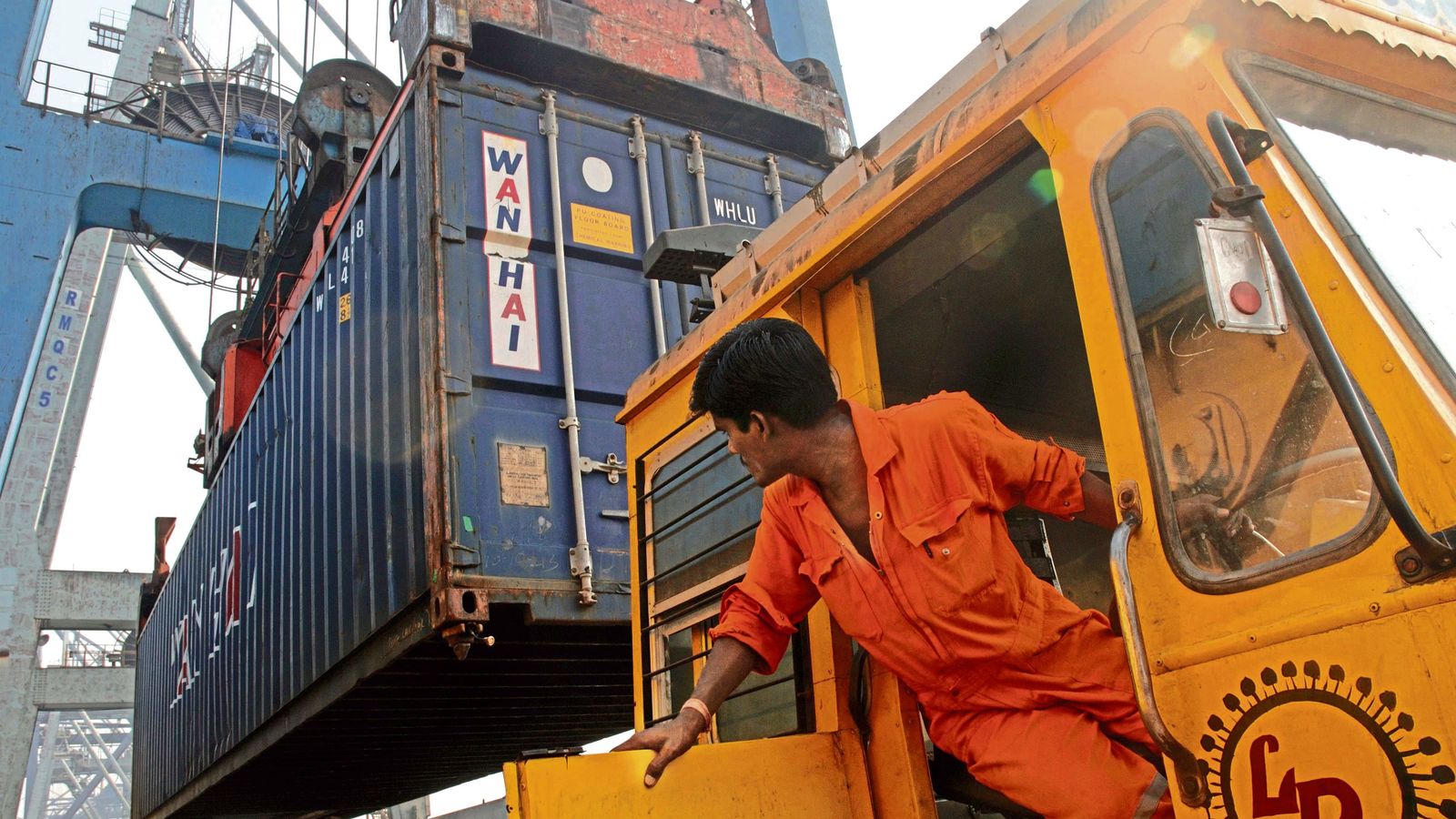
India's exports jump to $56.51 billion in October
The country's overall imports in October are estimated to be $68.09 billion, a growth of 57.32% over the same period last year and 40.82$ over October 2019
India's exports increase 35 pct in October - China.org.cn
www.china.org.cn
"India's overall exports, including merchandise and services, are estimated to be 369.39 billion U.S. dollars in April-October 2021, exhibiting a growth of 39.83 percent over the same period last year, and up 19.97 percent over April-October 2019, added the statement.
Overall imports in April-October 2021 are estimated to be 409.30 billion U.S. dollars, up 63.64 percent over the same period last year and a growth of 13.57 percent over April-October 2019."
This is some good news, (total) export growth is outpacing (total) import growth using 2019 pre-pandemic reference.
We might soon see 700 billion export and 800 billion import yearly level for India.
Progress to a trillion each might happen sooner than previously expected too.

India's exports jump to $56.51 billion in October
The country's overall imports in October are estimated to be $68.09 billion, a growth of 57.32% over the same period last year and 40.82$ over October 2019www.livemint.com
India's exports increase 35 pct in October - China.org.cn
www.china.org.cn
"India's overall exports, including merchandise and services, are estimated to be 369.39 billion U.S. dollars in April-October 2021, exhibiting a growth of 39.83 percent over the same period last year, and up 19.97 percent over April-October 2019, added the statement.
Overall imports in April-October 2021 are estimated to be 409.30 billion U.S. dollars, up 63.64 percent over the same period last year and a growth of 13.57 percent over April-October 2019."
This is some good news, (total) export growth is outpacing (total) import growth using 2019 pre-pandemic reference.
We might soon see 700 billion export and 800 billion import yearly level for India.
Progress to a trillion each might happen sooner than previously expected too.

Samsung to manufacture more "Make in India" smartphones as company shifts production from Vietnam: Report
Following the restructuring, India will manufacture 29 percent of Samsung’s total smartphones worldwide.
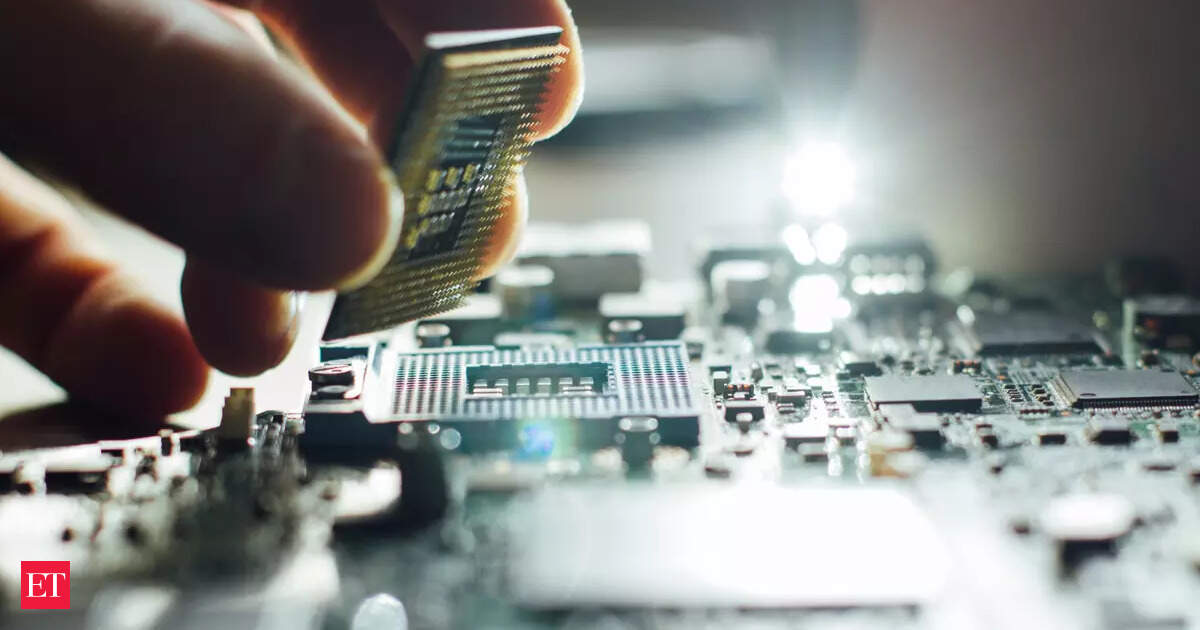
India accelerates talks with Taiwan on $7.5-billion chip plant, trade deal
Officials in New Delhi and Taipei have met in recent weeks to discuss a deal that would bring a chip plant worth an estimated $7.5 billion to India to supply everything from 5G devices to electric cars.economictimes.indiatimes.com
India and Taiwan are in talks on an agreement that could bring chip manufacturing to South Asia along with tariff reductions on components for producing semiconductors by the end of the year, people familiar with the matter said, a move that may spark fresh tensions with China.
Officials in New Delhi and Taipei have met in recent weeks to discuss a deal that would bring a chip plant worth an estimated $7.5 billion to India to supply everything from 5G devices to electric cars, the people said. India is currently studying possible locations with adequate land, water and manpower, while saying it would provide financial support of 50% of capital expenditure from 2023 as well as tax breaks and other incentives, the people said.
Officials in Taipei wanted quick progress on a bilateral investment agreement that would include tariff reductions on dozens of products used to make semiconductors -- a precursor to a broader trade deal also under consideration, the people said.
The people asked not to be identified to discuss negotiations that were currently ongoing. The Office of Trade Negotiations under Taiwan’s cabinet declined to comment, while a spokesperson for India’s trade ministry didn’t immediately respond to a text message.
The trade talks come at a time when democracies across the world are boosting economic and military links to stand up against an increasingly assertive China. While Taiwan has long sought a trade deal with India, officials in New Delhi had been hesitant to anger Beijing, which claims the island democracy as its territory.
The discussions have accelerated in recent weeks as U.S. President Joe Biden seeks to shore up supplies of chips, strengthen supply chains among democracies and improve military capabilities in the region. On Friday, he met Indian Prime Minister Narendra Modi along with the leaders of Australia and Japan as part of the Quad meeting, a group that is countering China’s influence.
India has also taken a bolder stance against China since a protracted border standoff following violent clashes in 2020 in which at least 20 Indian and four Chinese soldiers were killed.
While India and Taiwan are laying the groundwork to discuss a comprehensive trade deal covering goods, services and investments, officials in Taipei are seeking to revise the investment deal to show some early progress.
India has sought to lure high-technology investments as it seeks to become more self-reliant on chips, while Taiwan wants to strengthen its diplomatic presence around the globe as it pushes back against the pressure from China. Beijing has vowed to work toward unifying the island democracy with the mainland, even by force if necessary.
Chip shortages have delayed the much-anticipated launch of a smartphone by billionaire Mukesh Ambani’s Reliance Industries that has been co-engineered with Google. Currently India imports almost all semiconductors to meet demand estimated to reach around $100 billion by 2025 from about $24 billion now.
Taiwan has welcomed cooperation between the two sides on semiconductors although it is still evaluating the proposal given a lack of ecosystem for setting up a chip fabrication plant in India, people familiar with the matter said. The Taiwan side has flagged concerns on the supply of water and electricity, and suggested that it may be more feasible for India to start creating a chip design sector first before proceeding to building fabs, according to one of the people.
India and Taiwan in 2018 signed a bilateral investment agreement to promote investment flows and expand economic ties between the two nations. Trade between them stood at $5.6 billion in the fiscal year ended March, according to India’s trade ministry.
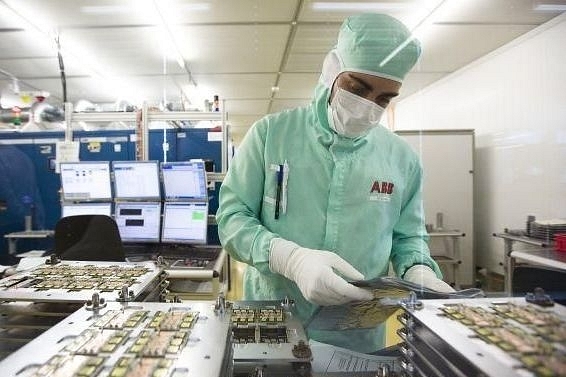
India To Unveil A Package Of Incentives For Semiconductor Chip Manufacturing: PM Modi At The Sydney Dialogue
Prime Minister Narendra Modi revealed today that India is working on slew of incentives to global semiconductor manufacturing companies to set up chip production facility in India.
swarajyamag.com
Delivering the keynote address at The Sydney Dialogue today on the theme "India's technology evolution and revolution", Prime Minister Narendra Modi revealed that India is working on offering slew of incentives to global semiconductor manufacturing companies to set up chip production facility in India.
"We are focussing on hardware. We are preparing a package of incentives for becoming a key manufacturer of semiconductors." the Prime Minister during his address
(Incentive package for semiconductor manufacturing at 12:05m of video below)
While there have been several speculative reports in the media over India's plans to offer subsidies for semiconductor (chip) manufacturing , this is the first time that Prime Minister himself has indicated that the government is working towards unveiling an package.
Earlier this month, The Times Of India reported that the Indian government is set to roll out a mega multi-billion-dollar capital support and production-linked incentive plan to push manufacturing of semiconductors in the country.
According to the report, senior officers are engaged in active discussions with some of the top semiconductor makers such as Taiwan Semiconductor Manufacturing Co. (TSMC), Intel, AMD, Fujitsu, United Microelectronics Corp.
While TSMC and UMC are Taiwan based pure play foundries which do contract manufacturing of chips, AMD is a fabless company which focuses mainly on design of chips. Intel and Fujitsu are Integrated Device Manufacturers which do both design as well as fabrication of chips in their own foundries.
According to few industry sources the Prime Minister's Office (PMO) is coordinating the efforts to design attractive incentives to lure leading chip manufacturers. The incentive likely to be offered include financial support on capital expenditure, tariff reductions on certain key components and Production-Line Incentive (PLI) scheme on lines offered to several strategic sectors. The government is also working on additional incentives to boost fabless startups also in India.
Historically TSMC has not been keen expanding its footprint outside Taiwan. Morris Chang, the founder of Taiwanese chip manufacturing behemoth, has repeatedly expressed concern over the concerted efforts by nations to bring chip production onshore in a bid to achieve self-sufficiency in semiconductors. However worries over supply chain shocks and growing geopolitical concerns about China's expansionist designs — concerns have drive U.S.to get TSMC and competitors to set up shop on U.S. soil too.
Earlier this month, TSMC announced that it is forging a partnership with Sony to build a new chip manufacturing unit in Japan with Sony and start producing chips by 2024.
If India is able to persuade TSMC or any of the leading chip manufacturers to set up a facility here , it can potentially leapfrog to cutting edge of chip production. It is also possible that it could settle for a "mature node" technology like 22nm or 28nm.
Some analysts believe that India could offer incentives for TSMC or leading manufacturers modelled along the lines of what Japanese government offered. In bid to regain its competitiveness in chip manufacturing, Japan offered subsidies up to $3.5 billion out of a total estimated cost of $7 billion for the upcoming TSMC-Sony fab.
My hometown 
 indiainfrahub.com
indiainfrahub.com
In a big boost to ‘Make In India’ and Aatmanirbhar Bharat initiative of the government, French multinational rolling stock manufacturer Alstom has inaugurated its new components manufacturing facility in Tamil Nadu’s Coimbatore.
This is the largest components manufacturing facility in Asia and is dedicated to improving industrial efficiency in manufacturing components for various prestigious national and international projects, Alstom said in a statement on Tuesday (16 November).
The company said that its industrial presence in Coimbatore has evolved across three sites since 1978.
The new site is spread over a total area of 15 acres and has an installed capacity of 2.1 million hours, that will offer a higher degree of production diversity and complexity – integration and testing of tractions, auxiliary convertors, cubicles, driver desks and Rolling Stock looms, it added.
The site will create 10,000 direct and indirect jobs and currently has a gender diversity rate of 20 per cent, according to the company.
The Coimbatore site currently delivers not just to Alstom’s Indian sites but also to major sites across five continents – Asia, Australia, Europe, North America and South America, the company said.
Speaking at the inauguration, Alain Spohr, Managing Director, Alstom India said, “Our presence in Coimbatore dates to the 1970s and since then we’ve grown multifold. The opening of this facility is a testament of our commitment to the government’s flagship ‘Make in India’ & ‘Atmanirbhar Bharat’ initiative”.
“With our enhanced capabilities and a team of talented and dedicated employees, we are proud to be a catalyst in India’s manufacturing led growth story. We have been the preferred mobility partner on various Indian projects and are keenly looking forward to becoming a leading supplier of components across Alstom’s sites globally,” Spohr added.
============

 www.financialexpress.com
www.financialexpress.com
Make In India: Alstom Inaugurates Asia's Largest Components Manufacturing Facility In Tamil Nadu's Coimbatore - India Infra Hub
In a big boost to ‘Make In India’ and Aatmanirbhar Bharat initiative of the government, French multinational rolling stock manufacturer Alstom has inaugurated its new components manufacturing facility in Tamil Nadu’s Coimbatore. This is the largest components manufacturing facility in Asia and...
 indiainfrahub.com
indiainfrahub.com
In a big boost to ‘Make In India’ and Aatmanirbhar Bharat initiative of the government, French multinational rolling stock manufacturer Alstom has inaugurated its new components manufacturing facility in Tamil Nadu’s Coimbatore.
This is the largest components manufacturing facility in Asia and is dedicated to improving industrial efficiency in manufacturing components for various prestigious national and international projects, Alstom said in a statement on Tuesday (16 November).
The company said that its industrial presence in Coimbatore has evolved across three sites since 1978.
The new site is spread over a total area of 15 acres and has an installed capacity of 2.1 million hours, that will offer a higher degree of production diversity and complexity – integration and testing of tractions, auxiliary convertors, cubicles, driver desks and Rolling Stock looms, it added.
The site will create 10,000 direct and indirect jobs and currently has a gender diversity rate of 20 per cent, according to the company.
The Coimbatore site currently delivers not just to Alstom’s Indian sites but also to major sites across five continents – Asia, Australia, Europe, North America and South America, the company said.
Speaking at the inauguration, Alain Spohr, Managing Director, Alstom India said, “Our presence in Coimbatore dates to the 1970s and since then we’ve grown multifold. The opening of this facility is a testament of our commitment to the government’s flagship ‘Make in India’ & ‘Atmanirbhar Bharat’ initiative”.
“With our enhanced capabilities and a team of talented and dedicated employees, we are proud to be a catalyst in India’s manufacturing led growth story. We have been the preferred mobility partner on various Indian projects and are keenly looking forward to becoming a leading supplier of components across Alstom’s sites globally,” Spohr added.
============

Alstom inaugurates Asia’s largest components manufacturing facility in Coimbatore; details
The company's industrial presence in the city of Coimbatore has evolved across three sites since the year 1978.
@Jackdaws I remember the issues concerning navi mumbai airport earlier, is this timeline feasible in your opinion?
Yes. It's not a big deal considering it's quite far from the city. AFAIK most land acquisition is done which is always a challenge in Bombay, even in outskirts and then crz clearance.
@Jackdaws I remember the issues concerning navi mumbai airport earlier, is this timeline feasible in your opinion?



